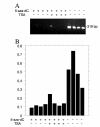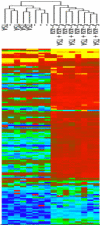Epigenetics of gene expression in human hepatoma cells: expression profiling the response to inhibition of DNA methylation and histone deacetylation
- PMID: 16854234
- PMCID: PMC1574318
- DOI: 10.1186/1471-2164-7-181
Epigenetics of gene expression in human hepatoma cells: expression profiling the response to inhibition of DNA methylation and histone deacetylation
Abstract
Background: DNA methylation and histone deacetylation are epigenetic mechanisms that play major roles in eukaryotic gene regulation. We hypothesize that many genes in the human hepatoma cell line HepG2 are regulated by DNA methylation and histone deacetylation. Treatment with 5-aza-2'-deoxycytidine (5-aza-dC) to inhibit DNA methylation with and/or Trichostatin A (TSA) to inhibit histone deacetylation should allow us to identify genes that are regulated epigenetically in hepatoma cells.
Results: 5-aza-dC had a much larger effect on gene expression in HepG2 cells than did TSA, as measured using Affymetrix HG-U133 Plus 2.0 microarrays. The expression of 1504 probe sets was affected by 5-aza-dC (at p < 0.01), 535 probe sets by TSA, and 1929 probe sets by the combination of 5-aza-dC and TSA. 5-aza-dC treatment turned on the expression of 211 probe sets that were not detectably expressed in its absence. Expression of imprinted genes regulated by DNA methylation, such as H19 and NNAT, was turned on or greatly increased in response to 5-aza-dC. Genes involved in liver processes such as xenobiotic metabolism (CYP3A4, CYP3A5, and CYP3A7) and steroid biosynthesis (CYP17A1 and CYP19A1), and genes encoding CCAAT element-binding proteins (C/EBPalpha, C/EBPbeta, and C/EBPgamma) were affected by 5-aza-dC or the combination. Many of the genes that fall within these groups are also expressed in the developing fetal liver and adult liver. Quantitative real-time RT-PCR assays confirmed selected gene expression changes seen in microarray analyses.
Conclusion: Epigenetics play a role in regulating the expression of several genes involved in essential liver processes such as xenobiotic metabolism and steroid biosynthesis in HepG2 cells. Many genes whose expression is normally silenced in these hepatoma cells were re-expressed by 5-aza-dC treatment. DNA methylation may be a factor in restricting the expression of fetal genes during liver development and in shutting down expression in hepatoma cells.
Figures


Similar articles
-
Differential regulation of the alcohol dehydrogenase 1B (ADH1B) and ADH1C genes by DNA methylation and histone deacetylation.Alcohol Clin Exp Res. 2006 Jun;30(6):928-37. doi: 10.1111/j.1530-0277.2006.00107.x. Alcohol Clin Exp Res. 2006. PMID: 16737450
-
Demethylation by 5-aza-2'-deoxycytidine in colorectal cancer cells targets genomic DNA whilst promoter CpG island methylation persists.BMC Cancer. 2010 Jul 12;10:366. doi: 10.1186/1471-2407-10-366. BMC Cancer. 2010. PMID: 20618997 Free PMC article.
-
Transcriptional silencing of the TMS1/ASC tumour suppressor gene by an epigenetic mechanism in hepatocellular carcinoma cells.J Pathol. 2007 Jun;212(2):134-42. doi: 10.1002/path.2173. J Pathol. 2007. PMID: 17471463
-
Epigenetic regulation of nervous system development by DNA methylation and histone deacetylation.Prog Neurobiol. 2009 Jul;88(3):170-83. doi: 10.1016/j.pneurobio.2009.04.002. Prog Neurobiol. 2009. PMID: 19554713 Review.
-
The Role of Histone Acetylation-/Methylation-Mediated Apoptotic Gene Regulation in Hepatocellular Carcinoma.Int J Mol Sci. 2020 Nov 24;21(23):8894. doi: 10.3390/ijms21238894. Int J Mol Sci. 2020. PMID: 33255318 Free PMC article. Review.
Cited by
-
Neonatal cytochrome P450 CYP3A7: A comprehensive review of its role in development, disease, and xenobiotic metabolism.Arch Biochem Biophys. 2019 Sep 30;673:108078. doi: 10.1016/j.abb.2019.108078. Epub 2019 Aug 22. Arch Biochem Biophys. 2019. PMID: 31445893 Free PMC article. Review.
-
Recent advances in 2D and 3D in vitro systems using primary hepatocytes, alternative hepatocyte sources and non-parenchymal liver cells and their use in investigating mechanisms of hepatotoxicity, cell signaling and ADME.Arch Toxicol. 2013 Aug;87(8):1315-530. doi: 10.1007/s00204-013-1078-5. Epub 2013 Aug 23. Arch Toxicol. 2013. PMID: 23974980 Free PMC article. Review.
-
Epigenetic and microRNA-mediated regulation in diabetes.Nephrol Dial Transplant. 2009 Apr;24(4):1088-96. doi: 10.1093/ndt/gfn728. Epub 2009 Jan 14. Nephrol Dial Transplant. 2009. PMID: 19145005 Free PMC article. No abstract available.
-
GATA4 loss of function in liver cancer impedes precursor to hepatocyte transition.J Clin Invest. 2017 Sep 1;127(9):3527-3542. doi: 10.1172/JCI93488. Epub 2017 Jul 31. J Clin Invest. 2017. PMID: 28758902 Free PMC article.
-
A Review on New Frontiers in Drug-Drug Interaction Predictions and Safety Evaluations with In Vitro Cellular Models.Pharmaceutics. 2025 Jun 6;17(6):747. doi: 10.3390/pharmaceutics17060747. Pharmaceutics. 2025. PMID: 40574059 Free PMC article. Review.
References
-
- Ng HH, Bird A. DNA methylation and chromatin modification. Curr Opin Genet Dev. 1999;9:158–163. - PubMed
-
- Kass SU, Pruss D, Wolffe AP. How does DNA methylation repress transcription? Trends Genet. 1997;13:444–449. - PubMed
-
- Riggs AD, Porter TN. Overview of epigenetic mechanisms. In: Russo VEA, Martienssen RA, Riggs AD, editor. Epigenetic mechanisms of gene regulation. Cold Spring Harbor: Cold Spring Harbor Laboratory Press; 1996. pp. 29–45.
-
- Ferguson AT, Vertino PM, Spitzner JR, Baylin SB, Muller MT, Davidson NE. Role of estrogen receptor gene demethylation and DNA methyltransferase. DNA adduct formation in 5-aza-2'-deoxycytidine-induced cytotoxicity in human breast cancer cells. J Biol Chem. 1997;272:32260–32266. - PubMed
Publication types
MeSH terms
Substances
Grants and funding
LinkOut - more resources
Full Text Sources
Other Literature Sources
Molecular Biology Databases
Research Materials

